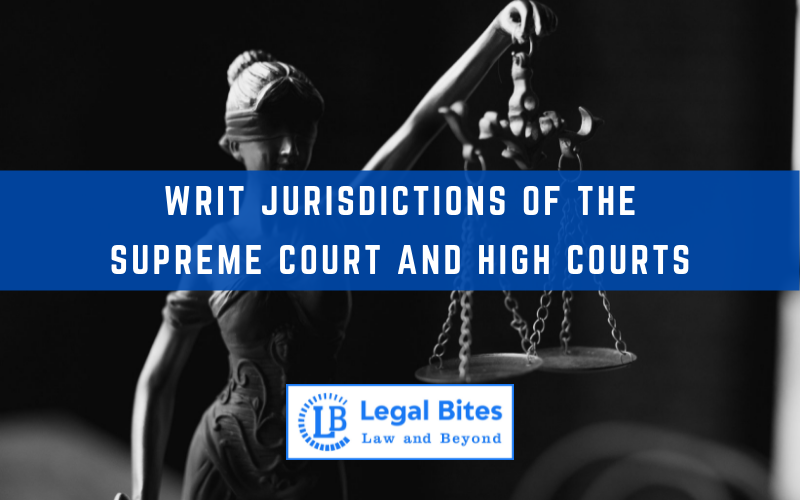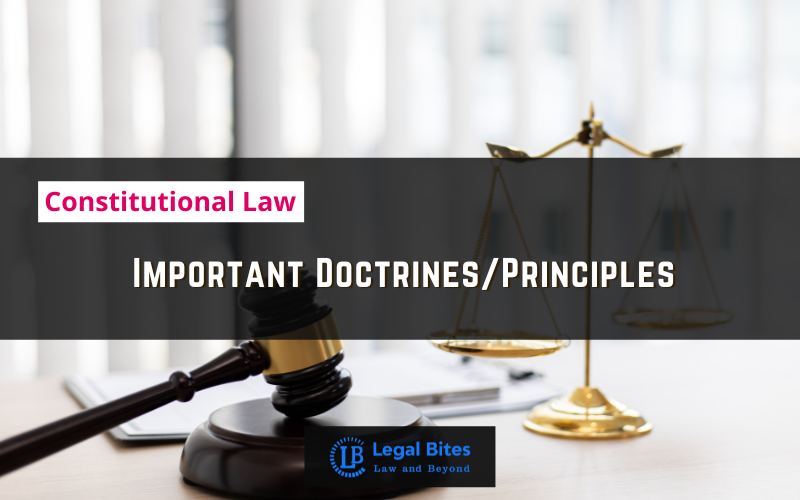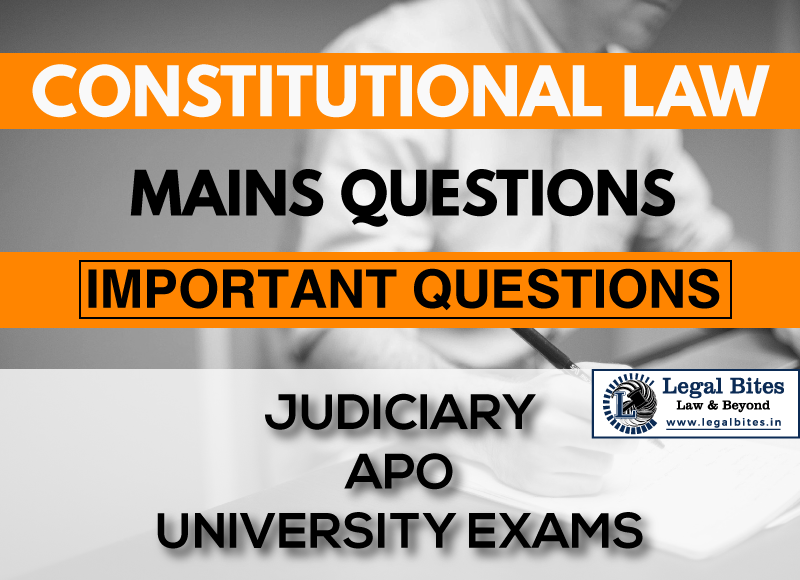Writ Jurisdictions of the Supreme Court and High Courts
A writ is a quick remedy against injustice, a device for the protection of the rights of citizens against any encroachment by the governmental authority. writs originated in Britain where they were king’s or queen’s ‘prerogative’ writs and were commands to the judicial tribunals or other bodies to do or not to do something. Since writs carried the… Read More »
;
A writ is a quick remedy against injustice, a device for the protection of the rights of citizens against any encroachment by the governmental authority. writs originated in Britain where they were king’s or queen’s ‘prerogative’ writs and were commands to the judicial tribunals or other bodies to do or not to do something. Since writs carried the authority of the crown they were to be obeyed. Later, writs came to be enjoyed by the judges of the King’s Bench. In...
A writ is a quick remedy against injustice, a device for the protection of the rights of citizens against any encroachment by the governmental authority. writs originated in Britain where they were king’s or queen’s ‘prerogative’ writs and were commands to the judicial tribunals or other bodies to do or not to do something. Since writs carried the authority of the crown they were to be obeyed. Later, writs came to be enjoyed by the judges of the King’s Bench. In India, the power to issue writs has been vested in the Supreme Court and the high courts. It is an extraordinary remedy that can be expected in special circumstances.
Writ Jurisdictions of the Supreme Court and High Courts
The Supreme Court has been empowered to issue writs in the nature of habeas corpus, mandamus, prohibition, and certiorari and quo warranto for protecting the fundamental rights [article 32(2)]. Similar power has been conferred on the high courts via article 226. The high court can issue the above writs for protecting the fundamental as well as statutory and common law rights. The high courts can issue writs to any governmental authority outside their territorial jurisdiction, provided the cause of action arises (in whole or in part) within their territorial jurisdiction.
A writ is a discretionary remedy and the high court can refuse it on the ground of acquiescence, laches (delay), available alternative remedy and no benefit to the party. Under Article 226(3), a high court can grant interim relief by way of interlocutory orders.
While the jurisdiction of the high court is more extensive than that of the Supreme Court, art. 226 (4) provides that the powers conferred on a high court shall not be in derogation of the powers conferred on the supreme court by article 32(2).
In L Chandra Kumar v. UOI, held that a person cannot go directly to the Supreme Court from a decision of a tribunal, without first going to the high courts. Thus, the aggrieved person has got another remedy by way of a writ petition before the high court concerned. Thus, what was earlier two-tier litigation has now become three-tier litigation. The tribunals cannot oust the jurisdiction of the high courts under articles 226/227.
The scope of the writs in Indian law is wider than that of the prerogative writs in England. This is because, firstly, the constitution uses the words “writs in the nature of which does not make our writs identical with those in England but only draws an analogy from the latter. Secondly, article. 32(2) do not require the Supreme Court to observe all procedural technicalities which were relevant for the issuance of writs under English law. Therefore, even if the conditions for the issue of any of the writs are not fulfilled, the court may still issue a writ in an appropriate case (except cases of government policy).
Thirdly, our high court can issue directions, orders or writs other than the prerogative writs. This enables the courts to mould the reliefs to meet peculiar and complicated requirements of this country. Under article 226, writs can be issued to “any persons or authority” (any person or body performing public duty).
There are five well-known writs:
1. Habeas Corpus
It literally means ‘a demand to produce the body’ or ‘you may have the body’ (whether dead or alive). the issuance of the writ means an order to the detaining authority or person to physically present before the court the detained person and show the cause of detention so that the court can determine its legality or otherwise (however, the production of the body of the person alleged to be unlawfully detained is not essential). If the detention is found to be illegal, the detained person is set free forthwith. Its purpose is not to punish the wrongdoer but merely to secure the release of the person illegally detained.
Since now, article 21 cannot be suspended even during the proclamation of emergency; this becomes a very valuable writ for safeguarding the personal liberty of the individual. While the Supreme Court can issue the writ of habeas corpus only against the state in cases of violation of fundamental rights, the high court can issue it also against private individuals illegally or arbitrarily detaining any other person.
Writ of habeas corpus can be filed by any person on behalf of the person detained or by the detained person himself. In Sunil Batra v. Delhi Administration, a letter written by a convict to one of the judges of the Supreme Court was treated as a writ petition. The court employed this writ for the neglect of state penal facilities. The writ was also issued when a ban was imposed on the law students to conduct interviews with prison mates for affording them legal relief.
2. Mandamus
It is a command to act lawfully and to desist from perpetrating an unlawful act. Where it has a legal right that casts certain legal obligations on b, a can seek a writ of mandamus directing to perform its legal duty? Mandamus may lie against any authority, officers, government or even judicial bodies that fail to or refuse to perform a public duty and discharge a legal obligation.
The Supreme Court may issue a mandamus to enforce the fundamental right of a person when its violation by some governmental order or act is alleged. The high courts may issue this writ to direct an officer to exercise his constitutional and legal powers, to compel any person to discharge duties cast on him by the constitution or the statute, to compel a judicial authority to exercise its jurisdiction and to order the government not to enforce any unconstitutional law.
Mandamus is a judicial remedy in the form of “‘an order’ to do or to forbear from doing some specific act” which that agency is obliged to do or to refrain from doing under the law and which is in the nature of a public duty or a statutory duty. It is considered as a residuary remedy of the public law.
It is a general remedy whenever justice has been denied to any person. It may be issued not only to compel the authority to do something but also to restrain it from doing something. Therefore, it is both negative and positive and hence can do the work of all other writs. It can be issued on all those counts on which certiorari and prohibition can be issued.
Mandamus would lie only to enforce a duty which is ‘public’ in nature. There must be a specific demand for the fulfillment of duty and there must be specific refusal by the authority. The applicant must have a legal right to the performance of a legal duty. If the rights are purely of a private character no mandamus can be issued. A ‘public duty’ is one which is created either by a statute, the constitution or by some rule of common law.
The public duty enforceable through mandamus must also be an absolute duty i.e. which is mandatory and not discretionary. Mandamus would not lie where the duty is ministerial in nature i.e. where the authority has to act on the instructions of his superior. The remedy of mandamus will not be available against any person involved in the election process.
In Jatinder Kumar v. State of Punjab, held that Article 320(3) of the constitution which provided that before a government servant was dismissed, the UPSC should be consulted, did not confer any right on a public servant and hence failure to consult the public service commission did not entitle the public servant to get mandamus for compelling the government to consult the commission. However, if the authority is under law obliged to exercise discretion, the mandamus would lie to exercise it in one way or the other.
In Praga Tools Corporation v. CVI Manual, held that mandamus could issue against a person or body to carry out the duties placed on them by the statutes even though they are not public officials or statutory bodies. Technicalities should not come in the way of granting that relief under Article 226. In Unni Krishnan v. Union of India, held that a private medical/engineering college comes within the writ jurisdiction of the court irrespective of the question of aid and affiliation.
In hearing the petition for mandamus, the court does not sit as a court of appeal. The court will not examine the correctness or otherwise of the decision on merits. It cannot substitute its own wisdom for the discretion vested in the authority unless the exercise of discretion is illegal. this is true for other writs also.
In UOI v. Prakash P. Hindu, it was held that Parliament exercises sovereign power to enact laws and no outside power or authority can issue a direction to enact a particular piece of legislation. Similarly, no mandamus can be issued to enforce an act that has been passed by the legislature. therefore, the direction issued by the apex court in the Vineet Narain case regarding conferment of statutory status on CVC cannot be treated to be of such a nature the non-compliance whereof may amount to contempt.
Where, however, the issuance of mandamus directing the investigating agencies to investigate into offences was found futile, the court forged out a new tool of “continuing mandamus” requiring the agencies to report the progress to the court so that monitoring by the court could ensure the continuance of the investigation.
3. Certiorari
‘Certiorari’ is a Latin word meaning ‘to inform’ or ‘to certify.’ it was essentially a royal demand for information. The king wishing to be certified of some matter ordered that the necessary information be provided for him. ‘certiorari’ may be defined as a judicial order operating in personam and made in the original legal proceedings, directed to any constitutional, statutory or non-statutory body or person, requiring the records of any action to be certified by the court and dealt with according to law.
it can be issued against constitutional bodies (legislature, executive and judiciary or their officers), statutory bodies like corporations, non-statutory bodies like companies and cooperative societies and private bodies and persons. Certiorari can be issued to quash judicial, quasi-judicial as well as administrative actions (AK Kraipak verses Union of India ). In this case, the writ of certiorari was issued to quash the action of a selection board, on the ground of personal bias.
The writ is corrective in nature, thus its scope of operation is quite large. The purpose of certiorari is not only negative (to quash an action) but it contains affirmative or positive action also. In Gujarat Steel Tubes v. Mazdoor Sabha, held that while quashing the dismissal order, the court can also order reinstatement and the payment of back wages.
Grounds for the issue of certiorari are:
(1) lack of jurisdiction; or the authority declining jurisdiction where it legally belongs to it.
(2) excess of jurisdiction.
(3) abuse of jurisdiction.
(4) violation of the principles of natural justice.
(5) error of law apparent on the face of the record – it includes not a mere error but a manifest error based on clear ignorance or disregard of the law, or on a wrong proposition of the law, or on clear inconsistency between facts and the law and the decision.
In Syed Yakoob v. Radhakrishnan, held that the jurisdiction of the high court to issue a writ of certiorari is a supervisory jurisdiction and the court exercising it is not entitled to act as an appellate court. An error of law which is apparent on the face of the record can be corrected by a writ, but not an error of fact, howsoever grave it may appear to be. However, if a finding of fact is based on ‘no evidence,’ that would be regarded as an error of law which can be corrected by certiorari.
IV. Prohibition
Prohibition is a judicial order to the agencies (constitutional, statutory or non-statutory) from continuing their proceedings in excess or abuse of their jurisdiction or in violation of the principles of natural justice or in contravention of the law of the land. it is issued primarily to prevent an inferior court or tribunal from exercising its jurisdiction (i.e. exercising power or authority not vested in them).
Prohibition does not lie against an authority discharging purely administrative or executive functions, it issues only against an authority discharging judicial functions (Isha Beevi v. Tax Recovery Officer).
Before the writ of prohibition can be issued there must be something to be done. It is a ‘writ of right’. Prohibition has much in common with certiorari’, both are ‘jurisdictional writs’ issued against judicial or quasi-judicial authorities on similar grounds. however, prohibition is issued while judicial process is in motion to prevent it from proceeding further, certiorari is issued to quash the proceedings and is therefore issued when the judicial process has ended in a decision (i.e. on completion of the proceeding). Thus, the object of the writ of prohibition is in short ‘prevention’ rather than cure, while certiorari is used as a ‘cure.’
However, these remedies may be applied simultaneously, certiorari to quash the proceedings and prohibition to stop the tribunal from continuing to exceed its jurisdiction. The usual practice is to pray for prohibition and alternatively certiorari because it may happen that pending proceedings for prohibition the agency may hand over its final decision.
V. Quo-Warranto
Quo-warranto is a question asking ‘with what authority or warrant’. The writ may be sought to clarify in public interest the legal position in regard to claim of a person to hold a public office. An application seeking such a writ may be made by any person provided the office in question is a substantive public office of a permanent nature created by the constitution or law and a person has been appointed to it without a legal title and in contravention of the constitution or the laws.
It can be issued against offices created by the constitution such as the advocate-general, the speaker of legislative assembly, officers under the municipal act, members of a local government board, university officials and teachers, but it will not issue against the managing committee of a private school which is not appointed under the authority of a statute.




